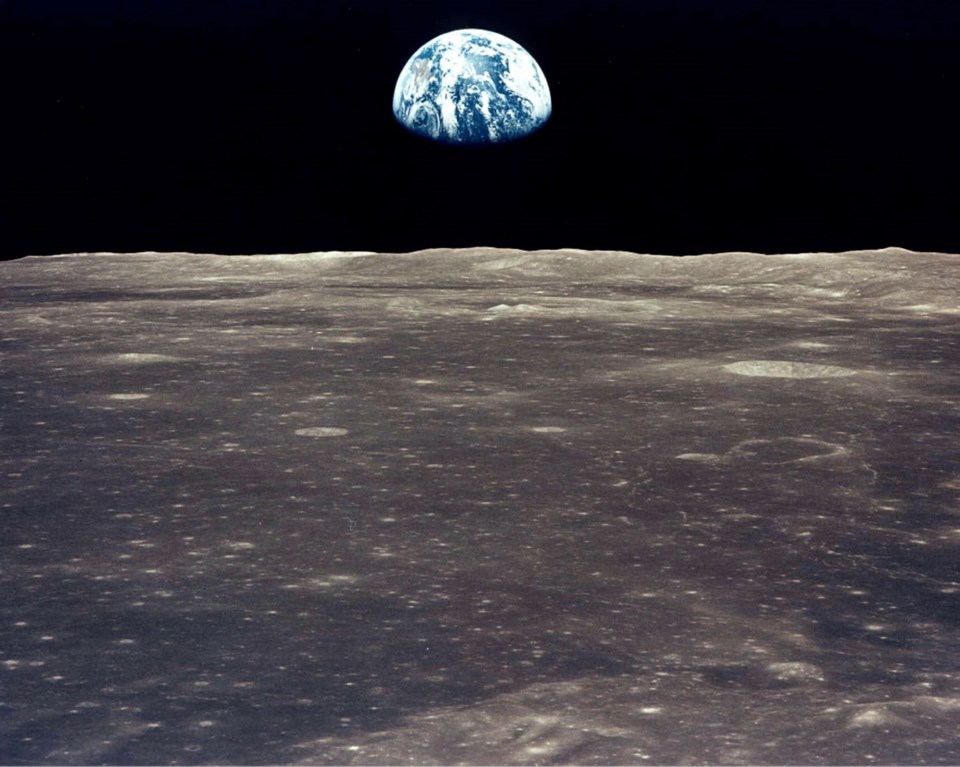The year began with images of a rocky body hanging in the blackness of space. Early on Jan. 1, scientists and engineers spending New Years at the Johns Hopkins University Applied Physics Lab in Maryland — including Victoria’s own planetary scientist J.J. Kavelaars — began receiving data of the most-distant space object visited and photographed by a spacecraft.
The two-lobed rock, then nicknamed Ultima Thule and now officially called Arrokoth, orbits our sun at a distance of about 4.5 billion kilometres. It’s one of the objects of the Kuiper Belt — a vast, sparsely populated region of icy worlds beyond Neptune.
The images of Arrokoth that were beamed to Earth early on Jan. 1 are not the first space images to make a sensation at this time of year. And they can’t compete with those taken by astronauts of the Apollo 8 mission.
Orbiting the moon aboard the Apollo 8 spacecraft in late December 1968, astronaut Bill Anders and his crewmates would have had home, family and the season on their minds.
Theirs was the first crewed U.S. mission to leave low Earth orbit, reach the moon, and orbit it.
Three days into their mission, they had been around the moon three times. Anders had photographed its desert terrain on both far and near sides, gathering information for geologists and NASA. “It didn’t take long for the moon to become boring,” he later said in an interview. “It was like dirty beach sand.”
As they completed their fourth orbit on Dec. 24, Frank Borman, the commander, rolled the spacecraft, and Earth hove into view.
Anders later described the sight as being “in a darkened room with only one visible object, a small blue — green sphere about the size of a Christmas-tree ornament.”
As I said, they might have had the holidays on their minds.
Anders wanted a photo. He quickly loaded colour film into his camera and started snapping away.
A couple of days later, the astronauts were back standing with their feet on that Christmas-tree ornament. The film was developed, and NASA released the photo. The agency had rotated it, so that the moon’s surface provided a familiar-seeming horizon that human viewers could orient themselves with, then cropped it.
We’re used to seeing the moon rising over Earth’s horizon. This image presented that view reversed.
Major newspapers and magazines ran it on their front pages and covers. In the American public consciousness, it quickly replaced the many iconic images of war and violence of the preceding decades — of the mushroom cloud of the nuclear-bomb explosion at Nagasaki, Japan, on Aug. 6, 1945, of Soviet soldiers raising their flag over the Reichstag in Berlin, on April 15, 1945, of a streetside execution during the Tet Offensive in Vietnam, from August 1968.
Called Earthrise, the photo became a symbol for peace, hope, and excitement. It showed us how petty our wars and squabbles are — with distance and perspective, political boundaries, differences in opinion, ideology, government, religion became meaningless.
The image also called attention to the need to take care of our fragile, lonely ball of rock and water and vapour spiralling through space — our home in the vast darkness of space. It helped fuel the environmental movement.
At the time, everything seemed possible — humans had orbited the moon! The moon, the Earth, even the universe were in our grasp. Technology was opening new horizons and opportunities. While problems existed — hunger, disease, poverty, injustice and all the other usual suspects, along with a Cold War — solutions seemed just within our reach.
Hope and peace — these are centuries-old themes of the season. The themes and the timing of the photo made Earthrise a fitting image for the turn of the year.
Since then, we’ve travelled further, explored more, seen more, saved lives, and solved problems. Both old and new challenges continue to test us.
Through it all, our blue-and-white Christmas-tree ornament keeps spinning along its path, regardless of what we do or don’t do — spend the holidays with our families, build the Trans Mountain pipeline, house the homeless, save the birds, the bees, the whales or the caribou, meet our climate targets, bring peace and happiness to all peoples, or send spacecraft and sports cars into space.
Whatever we do, this one Christmas-tree ornament remains up all year. We just need to remember it — and remember what it means.



